3 December. Locusts move to winter breeding areas
The Desert Locust situation remains calm in all countries.
In the Central Region, adults and a few small groups moved from the summer breeding area in eastern Sudan to the Red Sea coastal plains and northeastern subcoastal areas of Sudan. Low numbers of adults were present on the coast of Eritrea and Saudi Arabia. As good rains fell along both sides of the Red Sea, small-scale breeding was already underway in Eritrea and commenced during the last week of November in Sudan. Local breeding also occurred along the edge of the Empty Quarter in southern Oman where good rains fell in October from Cyclone Luban. During the forecast period, small-scale breeding will cause locust numbers to increase on the coastal plains along both sides of the Red Sea from southeast Egypt to central Eritrea and from northern Saudi Arabia to southwest Yemen. Small-scale breeding may also occur along the Gulf of Aden coastal plains in southern Yemen and northwest Somalia if more rains fall. Limited breeding may continue in southern Oman.
In the Western Region, small-scale breeding caused locust numbers to increase in western Mauritania, northern Mali and Niger, and southern Algeria near the Niger border. Groups formed in northeast Mali and southern Algeria, and ground teams treated 130 ha in southern Algeria. A few residual summer-bred populations of solitarious adults remained in northeast Chad. During the forecast period, small-scale breeding is likely to continue in Mauritania and may extend to the north of the country and to adjacent areas of Western Sahara, causing locust numbers to increase.
In South-West Asia, no locusts were reported and no significant developments are likely.
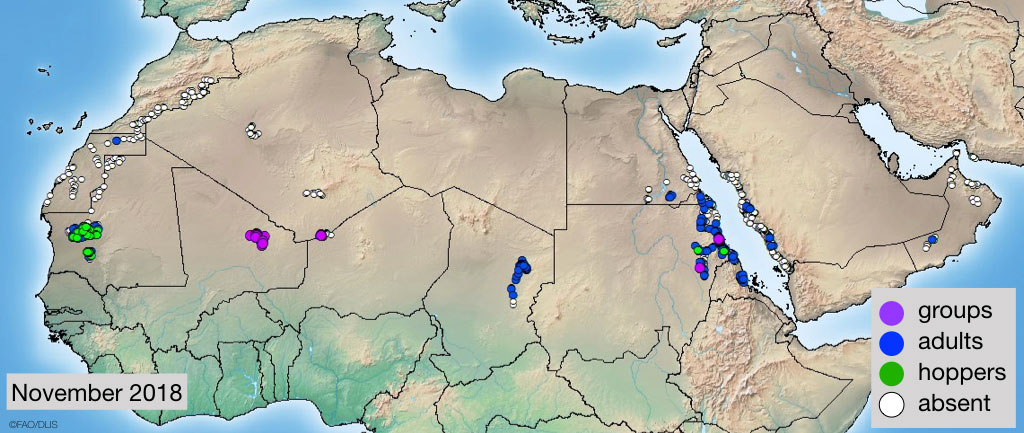
Current situation.
2 November. Locusts begin to shift from summer to winter breeding areas
The Desert Locust situation continues to remain calm.
Although seasonal rains ended in the northern Sahel of Africa between Mauritania and Sudan and vegetation was drying out, a second generation of breeding took place in Chad and small-scale breeding occurred in northern Niger and southern Algeria in October. There were unconfirmed reports of adult groups and breeding in northern Mali. In Mauritania, locusts moved from the south and are concentrating in western areas to form a few small groups. Some of the adults may have moved further north to northern Mauritania, Morocco and western Algeria during periods of southerly winds. Local breeding continued in central Algeria where 180 ha were treated. Scattered adults persisted in the interior of Sudan and began moving towards winter breeding areas along the Red Sea coast where early rains fell in some places.
Cyclone Luban brought heavy rains to eastern Yemen and southern Oman. Ecological conditions remained favourable in southern Oman and northwest Somalia from earlier cyclones Mekunu and Sagar in May, respectively. Local breeding was in progress in both areas and 70 ha of very small hopper and adult groups were treated with biopesticides on the northwest coast of Somalia.
The situation remained calm in southwest Asia.
During the forecast period, small-scale breeding is expected in northwest Mauritania where groups could form, and along both sides of the Red Sea.
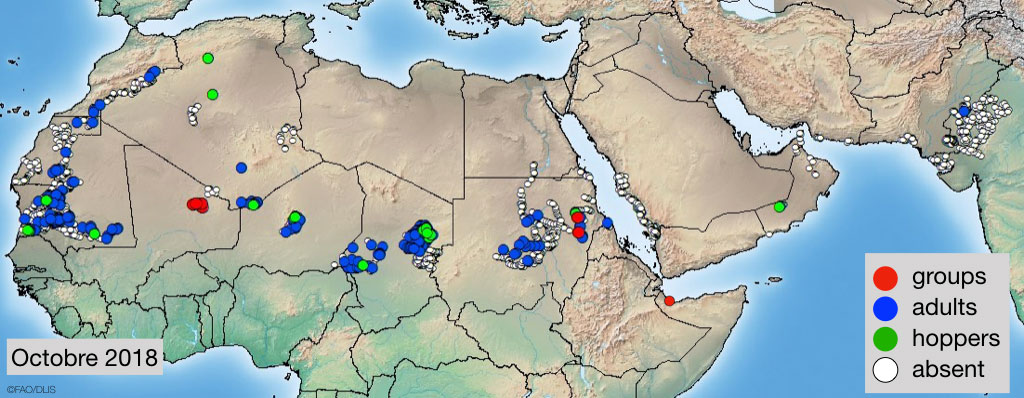
Current situation.
12 October. Cyclone Luban approaches southern Arabian Peninsula
Cyclone Luban began forming over the Arabian Sea (northern Indian Ocean) on about 8 October and, since then, it has been moving slowly west towards the Arabian Peninsula with winds increasing to 130 kmph. Scattered rains began falling on the 11th in Al Wusta and Dhofar regions of central and southern Oman with heavier rains forecasted for 13 October. Luban may intensify further before making its expected landfall on the southeastern coast of Yemen between Mukalla and Al Ghaydah on 14 October. Strong winds, heavy rainfall and potential flooding are expected in coastal areas of Al Maharah and portions of Hadramaut governorates in eastern Yemen as well as adjacent areas of southern Oman. The cyclone will decay and dissipate as it moves inland towards Saudi Arabia and the Empty Quarter.
Rains from the cyclone will cause ecological conditions to improve for Desert Locust survival and breeding in both countries. Although, locust numbers are currently very low, regular surveys will be required for several months in eastern Yemen and southern Oman from November onwards in order to detect any response by the locusts to the cyclone.
Elsewhere, the current Desert Locust situation remains calm because of limited breeding during the summer in parts of the northern Sahel between Mauritania and western Eritrea. As good rains fell in most places, summer breeding is likely to continue during October while thereafter vegetation will probably start to dry out. This may cause locusts to concentrate in a few areas such as western Mauritania and eastern Sudan. Isolated adults may also appear in areas of recent rainfall in Western Sahara, northern Mauritania and southeast Egypt.
Good rains fell on the Red Sea coastal plains in Saudi Arabia, Yemen and, to a lesser extent, in Eritrea last month that may allow small-scale winter breeding to commence earlier than usual in these areas.
The situation is expected to remain calm and no significant developments are likely.
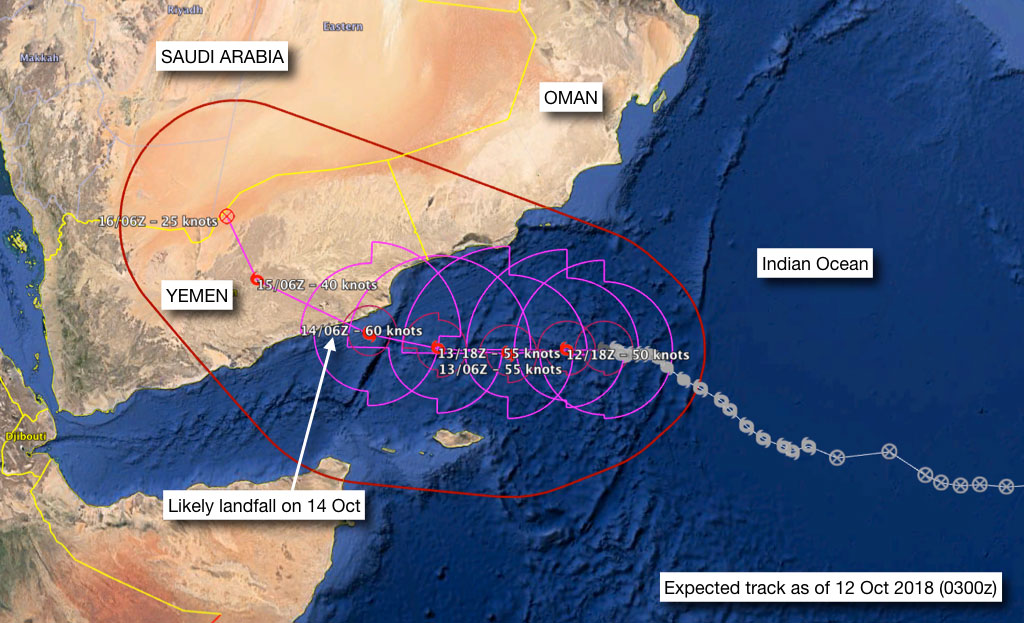
Cyclone Luban.
3 October. The Desert Locust situation remains calm with only small-scale summer breeding
Small-scale breeding occurred throughout September in parts of the northern Sahel between Mauritania and western Eritrea, but it was very difficult to detect during surveys as locust numbers remained extremely low and insignificant. As good rains fell in most places, summer breeding is likely to continue during October while thereafter vegetation will probably start to dry out. This may cause locusts to concentrate in a few areas such as western Mauritania and eastern Sudan. Isolated adults may also appear in areas of recent rainfall in Western Sahara, northern Mauritania and southeast Egypt.
Elsewhere, local breeding continued in central Algeria where 406 ha were treated in September by ground teams. Good rains fell on the Red Sea coastal plains in Saudi Arabia, Yemen and, to a lesser extent, in Eritrea. Small-scale winter breeding may commence early in these areas. Limited breeding occurred on the northwest coast of Somalia. In South-West Asia, locust numbers remained low where the monsoon withdrew from the Indo-Pakistan summer breeding areas at the end of September.
The situation is expected to remain calm and no significant developments are likely.
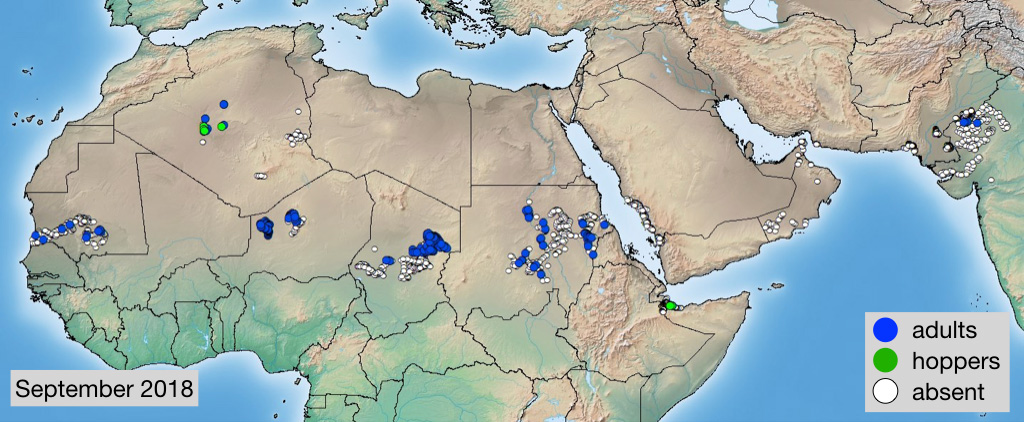
Desert Locust situation.
3 September. Good rains in summer breeding areas
The Desert Locust situation remains calm in all countries.
Only low numbers of solitarious adults are present in central Algeria, southeast Mauritania, northeast Chad, Sudan and along both sides of the Indo-Pakistan border. Despite good rains that fell unusually far north in the northern Sahel of West Africa and Sudan during August, very little breeding has been detected so far with the exception of isolated solitarious hoppers in the Adrar Valley of central Algeria where limited ground control operations were carried out.
During September, small-scale breeding will cause locust numbers to increase slightly in the summer breeding areas from Mauritania to western Eritrea. Limited breeding will continue along both sides of the Indo-Pakistan border. Scattered adults may appear on the Red Sea coast of Sudan, Eritrea, Yemen and southwest Saudi Arabia where early breeding could occur in those areas that received good rains in August.
Regular surveys should be maintained in all summer breeding areas during September with additional surveys on the Red Sea coast.
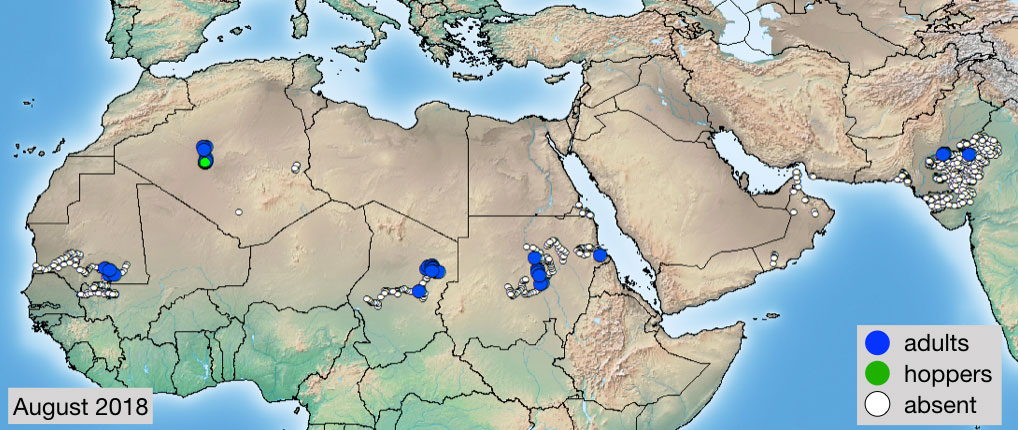
Desert Locust situation.
2 August. Good rains in summer breeding areas
The Desert Locust situation continues to remain calm in all countries.
Only isolated solitarious adults are currently present in central and eastern Algeria, southern Mauritania, Sudan and along the Indo-Pakistan border. Good rains fell during July in the summer breeding areas of the northern Sahel from Mauritania to western Eritrea and along both sides of the Indo-Pakistan border, causing ecological conditions to become favourable for breeding.
However, current locust numbers are extremely low due to very poor breeding during the past spring and winter. It will take several months of good rains and at least two generations of breeding before locust numbers are likely to increase significantly. Nevertheless, regular surveys should be undertaken in all summer breeding areas to closely monitor the evolution of the situation.
In the Central Region, there remains a possibility of breeding in southern and eastern Yemen, southern Oman, and eastern Saudi Arabia where unusually heavy rains from Cyclone Mekunu fell in May. There is a slight possibility of breeding in northern Somalia and eastern Ethiopia in areas that received heavy rains from Cyclone Sagar in May. Regular monitoring should be maintained in all areas for the next few months.
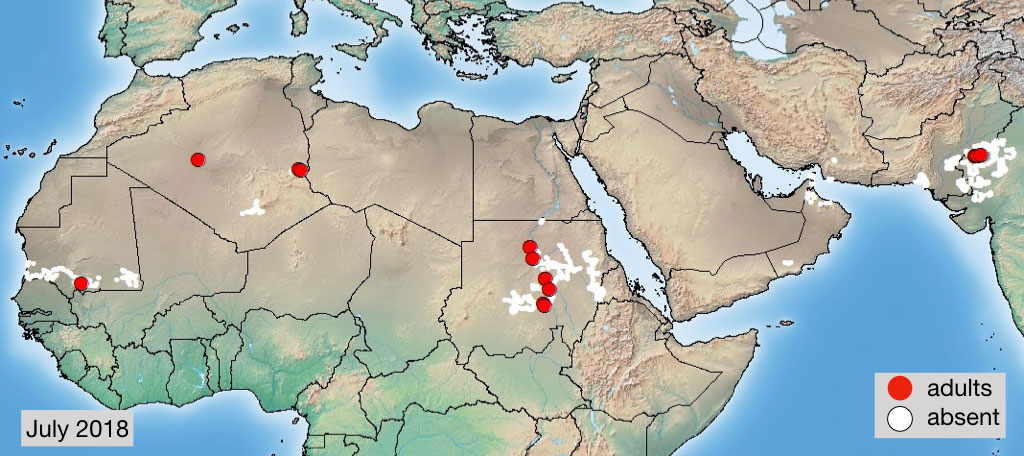
Desert Locust situation.
4 July. Desert Locust situation remains calm
Local breeding continued on a small scale in central Algeria where ground teams treated 581 ha of solitarious hoppers and adults near irrigated farms in June. In southwest Asia, isolated adults appeared in the summer breeding areas near the Indian border in Cholistan, Pakistan. No locusts have been reported in other countries.
During the forecast period, small-scale breeding will commence in the summer breeding areas of the northern Sahel between Mauritania and western Eritrea, initially in those places that have already received rainfall. As a result of very poor breeding during the past spring and winter, current locust numbers are extremely low throughout the recession area. A significant increase in locust populations will not occur unless there are several months of good rains and at least two generations of breeding. Nevertheless, regular surveys should be undertaken in all areas in order to detect the first signs of breeding and monitor progress.
In the Central Region, there remains a possibility of breeding in areas that received unusually heavy rains from cyclones Sagar and Mekunu in May, primarily in southern and eastern Yemen, southern Oman, eastern Saudi Arabia, northwest Somalia and eastern Ethiopia. Regular monitoring during the next few months is recommended.
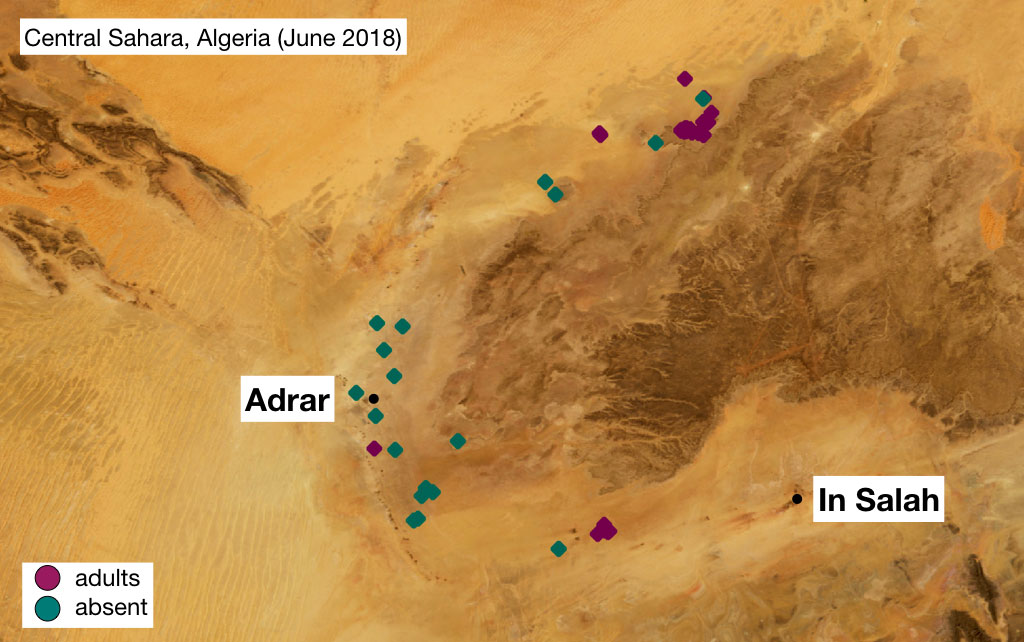
Desert Locust situation in central Algeria.
4 June. Ecological conditions likely to improve in areas affected by cyclones Sagar and Mekunu
Currently, the Desert Locust situation remains calm in all countries. Only low numbers of solitarious adults are present in central Algeria and on the southern coast of Yemen and Iran. Small-scale breeding occurred in central Algeria during April and May, and ground teams treated 228 ha.
June is typical the month in which locusts shift from spring to summer breeding areas. The movement this year is expected to be extremely limited due to poor breeding during this past winter and spring. Consequently, only low numbers of solitarious adults are likely to appear in southeast Mauritania, northeast Mali, northern Niger, the interior of Sudan and along both sides of the Indo-Pakistan border by the end of the month or shortly thereafter. Small-scale breeding will commence with the onset of the summer rains.
The heavy rains and floods associated with cyclones Sagar and Mekunu over the Horn of Africa and southern Arabia last month are likely to give rise to favourable breeding conditions later this month that could last for several months or more. As a precautionary measure, regular surveys are recommended to monitor ecological conditions and detect any signs of breeding in coastal and interior areas of eastern Yemen and southern Oman, the Empty Quarter of Saudi Arabia along the Yemen/Oman border, coastal and interior areas of northwest Somalia, and adjacent areas of eastern Ethiopia.
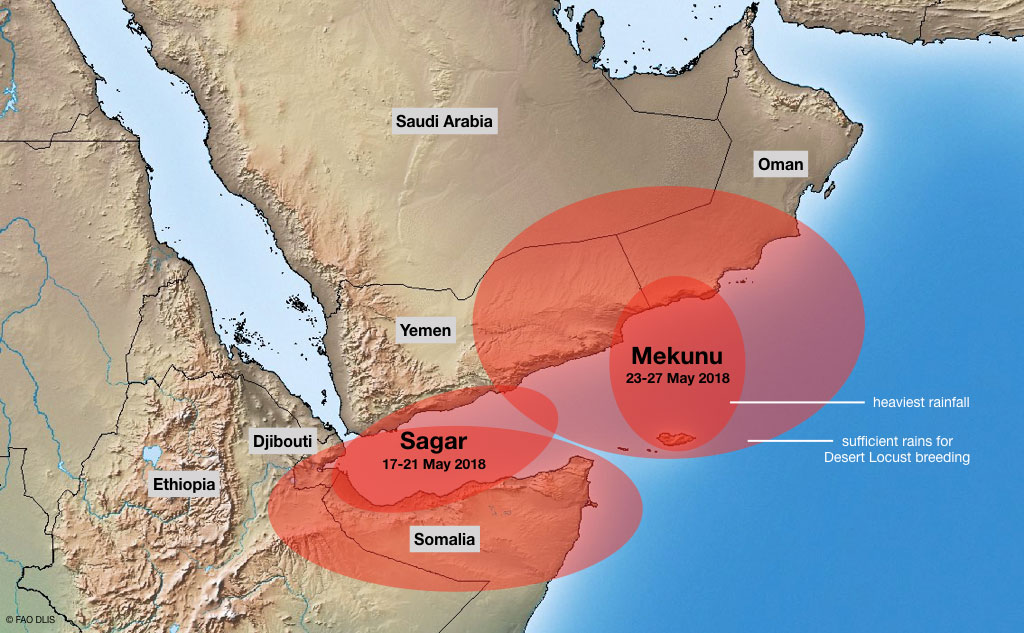
Estimated rainfall areas for cyclones Sagar and Mekunu.
23 May. Second cyclone develops in Arabian Sea & threatens Oman and Yemen
A new tropical storm has developed in the southwest Arabian Sea where it intensified yesterday evening into Cyclone Mekunu. The cyclone is moving currently north-northwest at a speed of 11 km/h. Mekunu is expected to continue moving in this direction during the remainder of this week and make landfall near Salalah, Oman on about Saturday 26 May.
A major fluctuation in tropical weather over the southern Arabian Sea known as the Madden-Julian oscillation (MJO) is likely to cause Mekunu to strengthen further.
As a result, heavy rains are forecasted for Socotra Island, followed by the southern Arabian coast from Sayhut in eastern Yemen to Salalah and Ash Shuwaymiyyah in southern Oman, which could cause local flooding and damage.
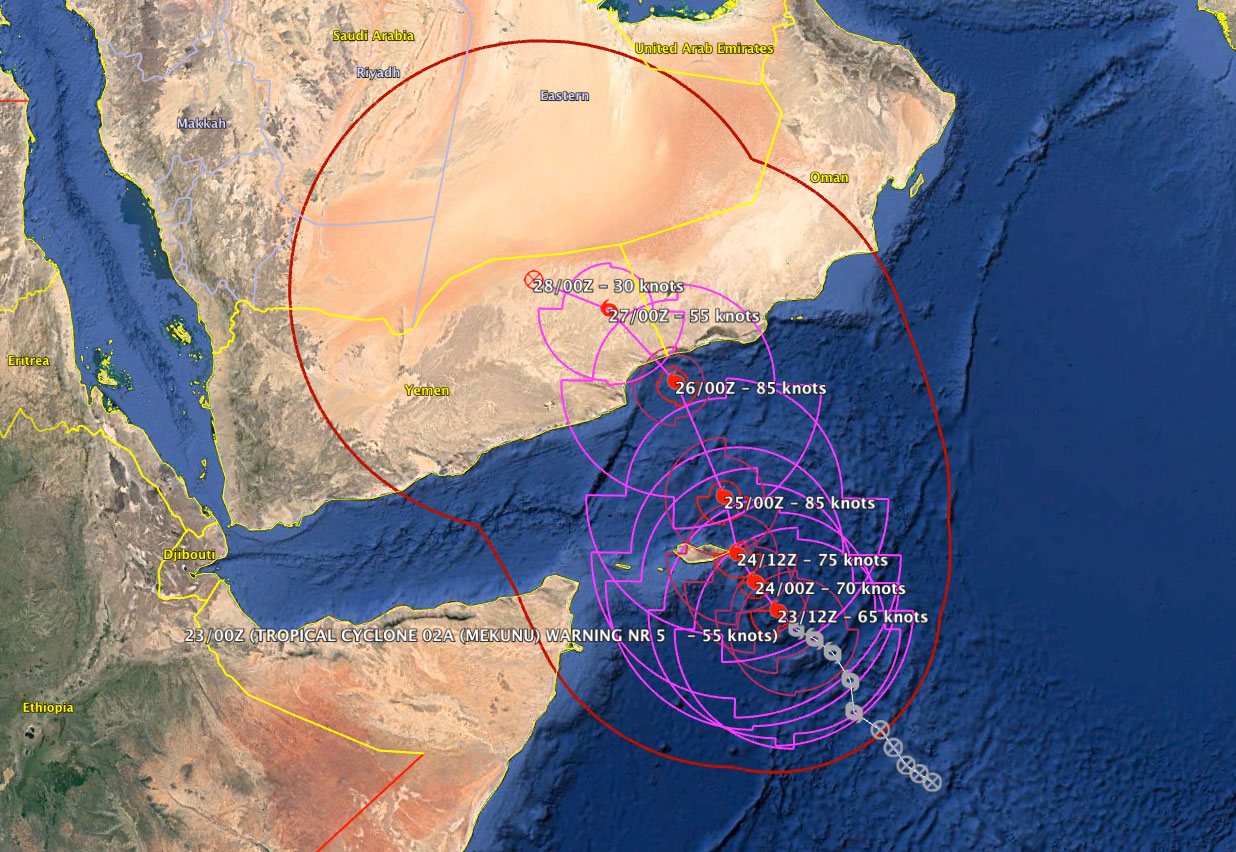
Forecasted track to 28 May.
18 May. Tropical cyclone to bring heavy rains to Yemen and northern Somalia
A rare tropical cyclone formed in the Gulf of Aden between Yemen and northern Somalia late on Wednesday, 16 May 2018. The cyclone, Sagar (TC01A), threatens to bring rains and dangerous flash flooding to desert areas of southern Yemen, northern Somalia and Djibouti.
On Thursday, the centre of the cyclone was about 400 km east of Aden, Yemen. Showers and thunderstorms were reported on the coast of southern Yemen to the west and east of Aden and on the coast of northern Somalia near Berbera.
By today (Friday), Sagar had gained strength with estimated tropical storm force winds. Heavy rainfall, up to about 50 to 125 mm could fall in coastal areas and cause flooding. Heavier rains up to 250 mm could fall in the escarpment and plateau of northwestern Somalia.
Sagar is expected to continue west-southwestwards making landfall in northwest Somalia or perhaps Djibouti on about Saturday, 19 May.
Since satellite monitoring and tracking began in 1964, only two tropical cyclones have moved into the western Gulf of Aden, cyclone Megh (November 2015) and TS1A (May 1984). Tropical cyclones are common in the Arabian Sea during spring and autumn, associated with the southwest winds responsible for the summer monsoon in India and Pakistan.
As the Desert Locust situation remains calm in all countries, the impact of Sagar on Desert Locust is likely to be limited. Nevertheless, any heavy rains that fall could eventually cause breeding conditions to become favourable, primarily along the southern coast of Yemen and in parts of the Horn of Africa.
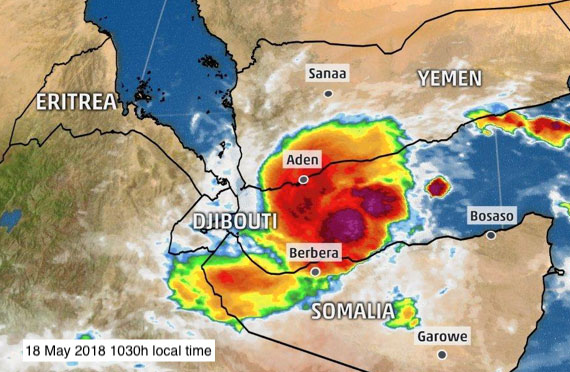
18 May 2018 situation.
3 May. Desert Locust situation continues to be calm
No locusts were reported during April except for isolated solitarious adults in central Algeria and southeast Iran. Good rains fell during the month in the interior of Saudi Arabia but annual vegetation was slow to respond and breeding conditions remained generally unfavourable similar to other spring breeding areas in Northwest Africa and South-West Asia. Good rains also fell on the Red Sea coast of Yemen and Eritrea. No locusts were seen during extensive surveys in Saudi Arabia, Pakistan and India, and other surveys carried out in Algeria, Egypt, Oman and Yemen.
During May, small-scale breeding may occur in central Algeria and the Jaz Murian Basin in southeast Iran, and perhaps in areas of recent rainfall in the interior of Saudi Arabia and on the Red Sea coast in Yemen. However, no significant developments are likely because of the poor rainfall and very low numbers of locusts this year in the spring breeding areas.
In general, the Desert Locust situation will continue to remain calm and non-threatening.
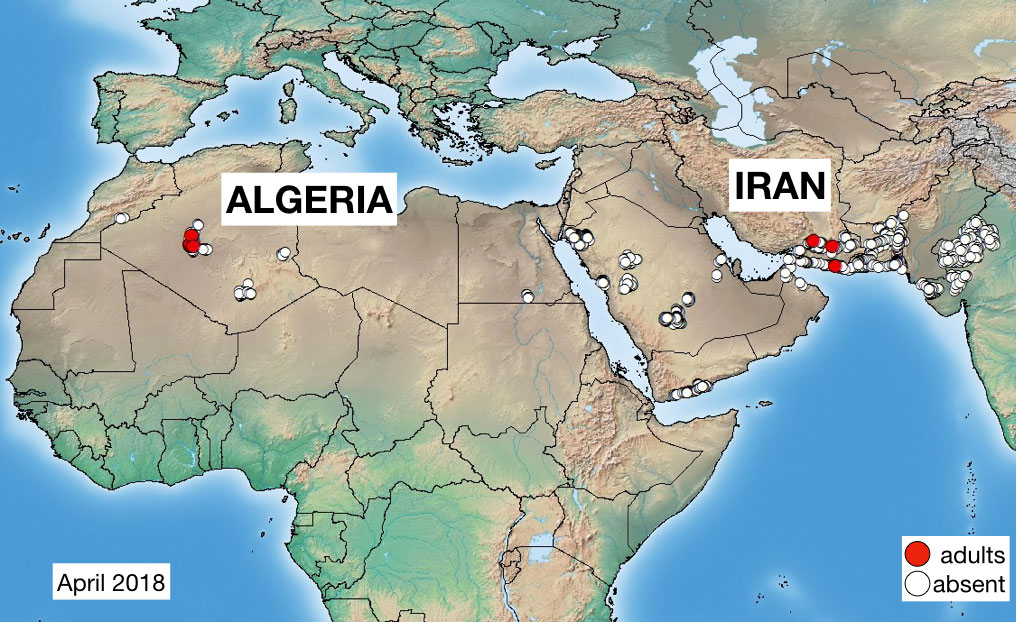
Winter breeding situation.
2 April. Desert Locust situation remains calm
Unusually dry and unfavourable breeding conditions prevailed and locust populations did not increase this year during the winter as a result of poor rainfall for four consecutive months. Consequently, current locust numbers are very low in all areas and this is expected to continue during the spring and summer unless good rains fall.
No locusts were reported in March except for isolated solitarious adults at one location in the central Sahara of Algeria and in one area on the southern coast of Yemen. Light rains commenced in parts of the spring breeding areas in the interior of Saudi Arabia and along both sides of the Iran-Pakistan border.
If more rains fall during the forecast period in these areas and along the southern side of the Atlas Mountains in Morocco and Algeria, then small-scale breeding could occur but locust populations will remain low and no significant developments are likely.

Winter breeding situation.
2 March. Calm situation persists because of poor winter rainfall
No significant rain fell for the third consecutive month in the winter breeding areas along both sides of the Red Sea during February. Consequently, unusually dry and unfavourable breeding conditions persist in most areas. No locusts have been reported except for scattered mature solitarious adults at two places on the Red Sea coast of Sudan.
The poor rainfall this year has kept locust numbers very low in the traditional winter breeding areas along both sides of the Red Sea at the time of year when locusts generally increase in number. Low temperatures and poor rainfall so far in the spring breeding areas suggest that breeding is likely to be limited and on a very small scale this year in Northwest Africa, the interior of Saudi Arabia and in southeast Iran and southwest Pakistan during the spring.
Unless unusually heavy rainfall occurs followed by substantial breeding, it can be anticipated that only very low numbers of locusts will be present at the beginning of the summer in the Sahel of West Africa and Sudan, and along the Indo-Pakistan border.
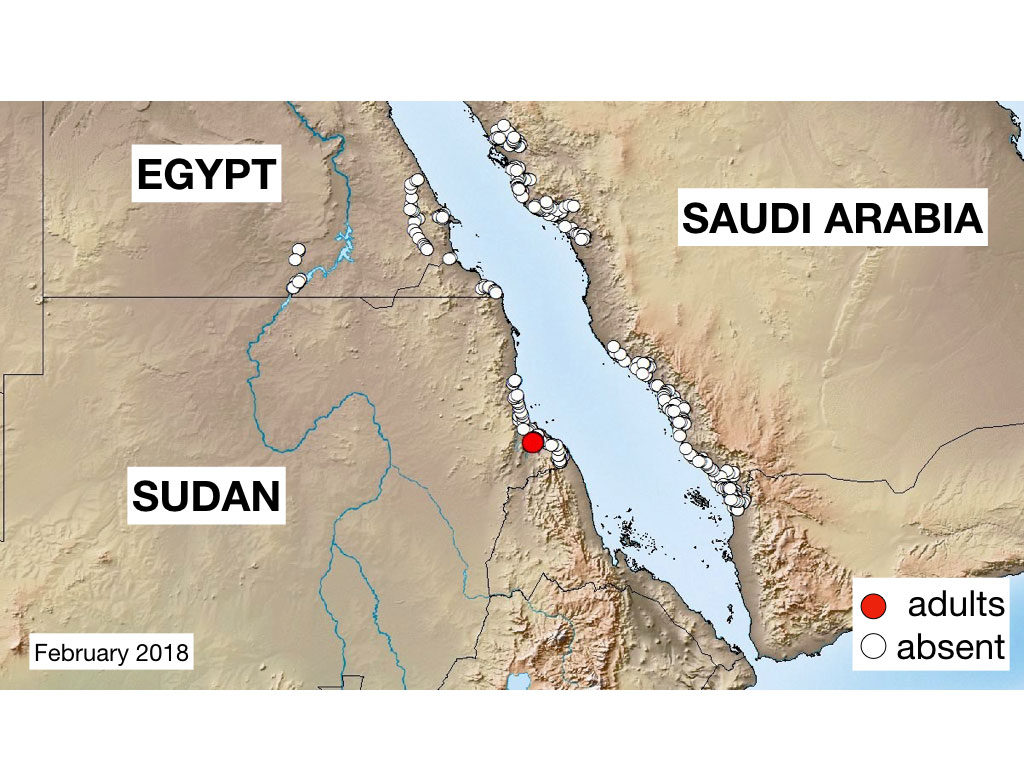
Winter breeding situation.
3 February. Calm situation continues due to poor rainfall in winter breeding areas
The Desert Locust situation continues to remain calm in all countries.
Very little rain has fallen in the winter breeding areas along both sides of the Red Sea and Gulf of Aden during the past two months. Consequently, ecological conditions are unusually dry and unfavourable for breeding in most areas. Only localized breeding on a small scale is likely to occur in some coastal areas of Sudan and Yemen where low numbers of solitarious adults were present in January. Small-scale breeding could also take place on the coast of Eritrea, Saudi Arabia and northern Somalia if additional rains fall during February.
Dry conditions prevailed elsewhere in the recession area and no locusts were reported.
During February and March, locust numbers will remain low and no significant development are likely. By mid-March, isolated adults may start to appear in the spring breeding areas in Northwest Africa and Southwest Asia.
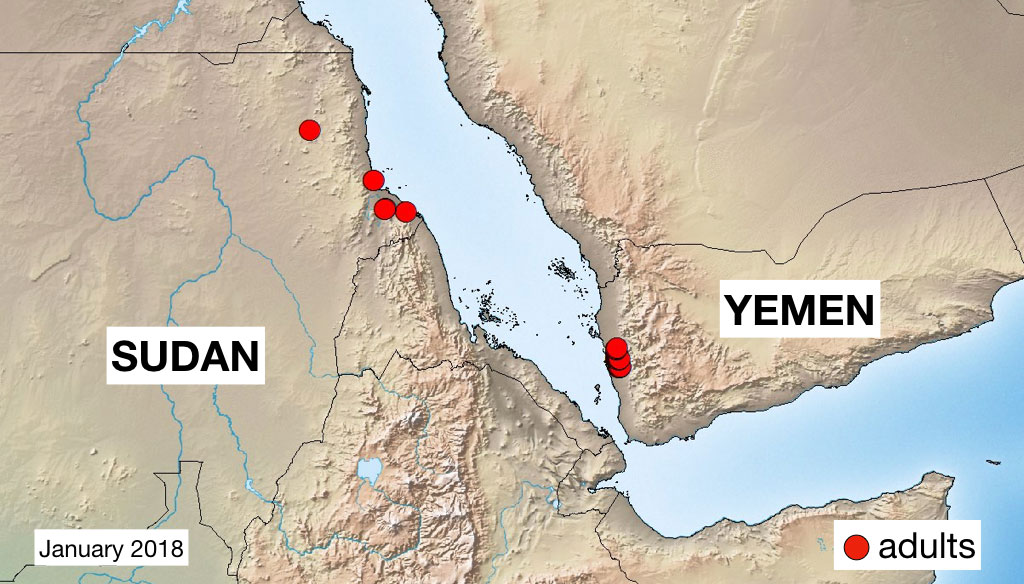
Winter breeding situation.
3 January. Calm situation due to poor rainfall in winter breeding areas
The Desert Locust situation continues to remain calm in all countries. As very little rain has occurred in the past month, ecological conditions are dry in most places except in parts of the winter breeding areas along both sides of the Red Sea and in a few places of northwest and northern Mauritania. So far, localized breeding has only been detected in one place on the Sudanese coast and in another place in northwest Mauritania. Low numbers of solitarious adults were present in both places. Elsewhere, locust numbers declined in Chad last month.
During January, small-scale breeding is expected to occur primarily on the Red Sea coast in Sudan as well as in areas that receive rainfall along both sides of the Red Sea and Gulf of Aden. Unless further rains fall, breeding will be limited and locust numbers will remain low. No significant development are likely.
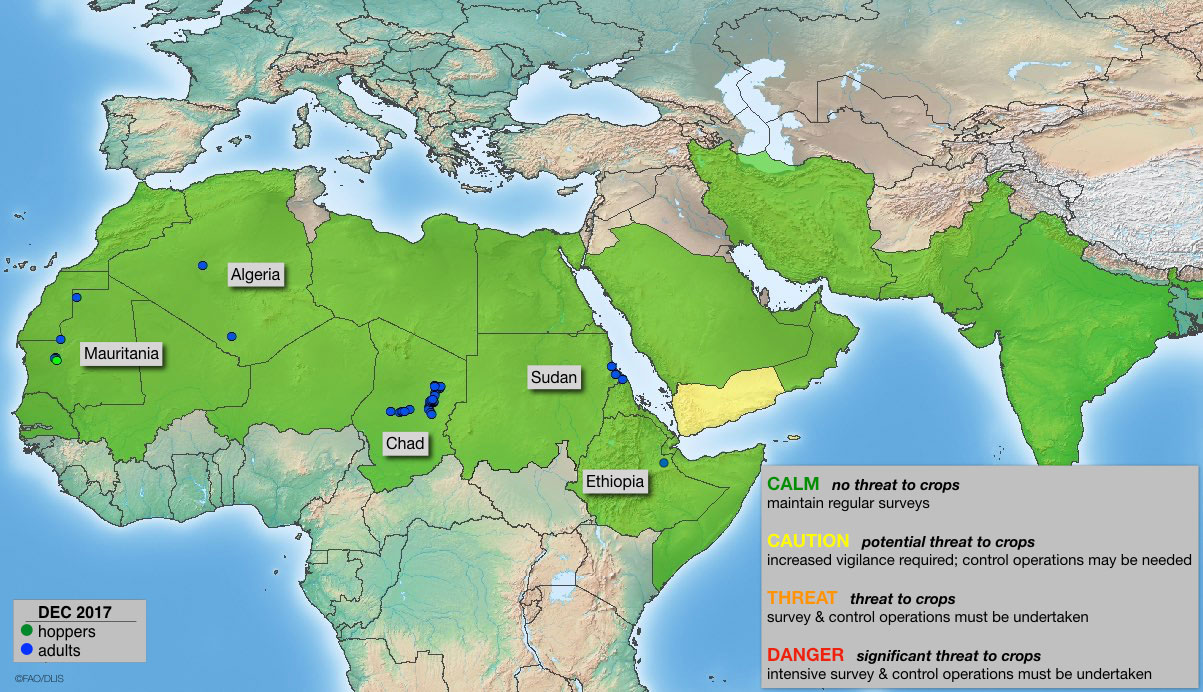
Current situation & threat.




